Design and Analysis of Automated Solar Panel Cleaning System
1
PDEA’s College of Engineering,
Manjari (Bk),
Pune,
Maharashtra
India
2
MES Wadia College of Engineering,
Pune,
Maharashtra
India
Corresponding author Email: sapcoeh@rediffmail.com
DOI: http://dx.doi.org/10.12944/CWE.18.3.11
Copy the following to cite this article:
Patil S. A, Patil A. R, Chougule V. N, Sanamdikar S. T. Design and Analysis of Automated Solar Panel Cleaning System. Curr World Environ 2023;18(3). DOI:http://dx.doi.org/10.12944/CWE.18.3.11
Copy the following to cite this URL:
Patil S. A, Patil A. R, Chougule V. N, Sanamdikar S. T. Design and Analysis of Automated Solar Panel Cleaning System. Curr World Environ 2023;18(3).
Download article (pdf) Citation Manager Publish History
Select type of program for download
| Endnote EndNote format (Mac & Win) | |
| Reference Manager Ris format (Win only) | |
| Procite Ris format (Win only) | |
| Medlars Format | |
| RefWorks Format RefWorks format (Mac & Win) | |
| BibTex Format BibTex format (Mac & Win) |
Article Publishing History
| Received: | 2023-08-08 |
|---|---|
| Accepted: | 2023-12-19 |
| Reviewed by: | 
 Grigorios Kyriakopoulos
Grigorios Kyriakopoulos
|
| Second Review by: |

 Pramod Behari Lal Chaurasia
Pramod Behari Lal Chaurasia
|
| Final Approval by: | Dr Gangadhar Andaluri |
Introduction
With the increasing adoption of renewable energy sources by both industries and residential consumers, photovoltaic solar panels have arisen as a pivotal resolution due to their global feasibility and availability. However, certain drawbacks associated with this technology, particularly concerning post-installation maintenance issues such as dust accumulation, have been identified. The settling of dirt elements on the solar surfaces of panels can steer to significant harm to their internal components¹. The types of suspended particles vary based on the geographical location of the installed system and the surrounding environment. These particulates have a detrimental impact on the efficiency of these solar technologies, resulting in decreased energy yields and heightened operation and maintenance costs².
Diverse solutions exist in the present scenario, but their applicability depends on the quantity of panels involved. For instance, extensive solar parks, such as large-scale solar power plants, employ automated solar panel cleaning mechanisms³. While effective, these mechanisms tend to be operationally expensive, making them feasible primarily for sizable solar parks. Conversely, smaller systems rely on manual labour for cleaning, a risky endeavour in extreme conditions that poses potential harm to personnel and system integrity due to the methods employed³ (such as brushing that may damage panel surfaces).
The settling of airborne particulates on solar panels can profoundly affect the functionality of the embedded photovoltaic cells. Given that these light-sensitive cells facilitate the transformation of solar to electrical energy, proper alignment according to that installation site's geographical conditions is vital?. Dust particles obstruct the necessary sunlight, leading to insufficient energy production, and the hindrance they create can result in severe damage to the silicon wafers within the panels. For example, even a small area with accumulated dust that blocks a cell can cause a burnout, manifesting as black spots on the panel. This issue varies based on the specific surroundings of the installation sites?. Industrial areas might emit various particles such as fly ash and brick powder, whereas areas with low buildings and residential zones could face issues like bird droppings. Dry regions like deserts are susceptible to sand accumulation due to frequent sandstorms. This predicament can lead to energy production reductions of up to 40-50% within specific timeframes, contingent on the location, ultimately undermining the solar system's efficiency and operability6.
Virtually all overhead residential and commercial solar panels are susceptible to dust settlement. The undertaking was launched to mitigate consumers' maintenance costs and time, constituting a primary objective of the endeavour?
Problem Statement
The presence of airborne particulates settling on solar panels can significantly impact the functioning of the embedded photovoltaic cells. These light-sensitive cells are responsible for converting solar energy into electricity, making it crucial to ensure an ample sunlight source through proper alignment according to the geographic characteristics of the installation site. These particles obstruct the required amount of sunlight, leading to insufficient energy production2. Additionally, the hindrance caused by these particles can result in severe damage to the silicon wafers inside. For instance, if dust accumulates and blocks a small area of a cell, it can cause the essential element within the cell to burn, resulting in the appearance of black spots on the panel's surface3.
The severity of this problem varies from one location to another, depending on the environmental surroundings of the installation sites. Industrial areas may emit various types of particles such as fly ash and brick powder, while areas with low buildings and residential neighbourhoods might face issues with bird droppings4. In dry regions like deserts, sand accumulation from frequent sandstorms can cover the panels. This problem can lead to a substantial reduction of 40-50% in energy production within a specific timeframe, depending on the location. Consequently, the overall efficiency of the solar system diminishes, making it challenging to operate and rendering it less effective5.
Objectives
The objectives of this work were
Design an automated solar panel cleaning mechanism for effective dust removal from the photovoltaic panels without causing any damage to the panel surface6.
Cleaning mechanism which can effectively run without any human intervention with the help of different sensors.
Design a frame on which the cleaning mechanism can be housed and it can be mobilized with ease without any effort6.
To determine appropriate material for the cleaning cloth and the frame of the mechanism for appropriate functioning
Fabricate the machine with locally available raw materials procured at an economical rate.
Customer Search
In this investigation, three distinct prospective marketplaces for cleaning the solar panel system were identified, each characterized by unique attributes. The primary market targets residential homeowners seeking solar solutions, typically characterized by a modest number of solar panels. While this market offers installation opportunities, the challenge arises from the relatively small number of panels owned by individual homeowners, making it necessary for any cleaning system targeting this market to be exceptionally cost-effective. After careful evaluation, it was decided not to target this market due to the difficulty of achieving cost objectives within a reasonable timeframe.
The secondary market encompasses sizable commercial entities leveraging extensive solar arrays to enhance energy production and enhance their environmental sustainability ratings. The advantage of this market lies in the larger scale of solar panels, which results in greater profit margins for potential cleaning unit installations.
However, the most promising and opportune market involves solar farms consisting of substantial solar panel arrays. These solar farms hold significant potential for the cleaning system due to their expansive scale and substantial panel count. The goal is to develop a solar panel cleaning system that surpasses manual labour in terms of speed and consistency while addressing safety concerns associated with cleaning panels in hazardous locations. The aim is to create a device capable of efficiently cleaning an entire row of solar panels, ultimately enhancing panel efficiency after each cleaning cycle. To remain competitive in the market, plans are in place to provide a cost-effective solution tailored to the number of panels cleaned.
Drawing inspiration from PDEA’s College of Engineering Manjari, which serves as an exemplary solar installation, the necessary design measurements were obtained, and the prototype was simulated on that system. The college features commercial-sized solar arrays, as depicted in Figure 1.
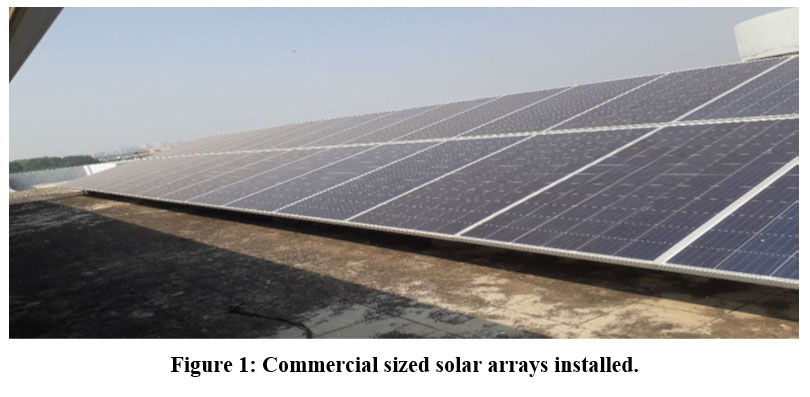 | Figure 1: Commercial sized solar arrays installed.
|
Furthermore, the significance of aligning the system's lifespan with that of a solar panel, which typically spans around 30 years, was recognized. Consequently, the primary emphasis during the design phase was placed on enhancing durability and ensuring long-term sustainability7. Given the environmental challenges in Pune, including drought and atmospheric conditions, dedication was directed toward the creation of a cleaning system that minimizes water usage in the cleaning process, thereby promoting eco-friendliness and sustainability8.
Literature Review
Motor Design
The insights into the impact of soiling on solar panels have been gleaned from research supported by universities and associations dedicated to solar energy. These studies delved into various facets of soiling, exploring its effects on solar panel performance3.
The research conducted by Boston University's Department of Electrical and Computer Engineering uncovered a significant 24% decrease in efficiency attributed to soiling in Lovington, New Mexico, over a one-month period. Notably, the study emphasized that while rain serves as a primary cleaning agent for solar panels, it is not entirely sufficient for optimal performance. The Boston University study also undertook a comprehensive analysis of costs and benefits associated with three prevailing solar panel cleaning methods. These approaches encompass regular cleaning via raining, manual cleaning, or cleaning facilitated by an electrodynamics system (EDS). The findings indicated that for rain to maximize its cleaning effect, panels should be equipped with a glass shield and positioned in a near-vertical orientation. Manual cleaning, involving water and detergent, was identified as effective but incurred notable labour costs (constituting 45.7% of the total cost) and fuel costs (constituting 20.5% of the total cost). The research thus provided valuable insights into the multifaceted considerations involved in maintaining optimal solar panel performance in the face of soiling challenges.
The IEEE study led by P. Burton and B. King delved into the impact of diverse types of dirt on solar panel efficiency, with a specific focus on the compositions commonly encountered in the south-western United States. Notably, the study discovered that yellow-colored dirt had a less detrimental influence on solar panel efficiency as compared to other types of dirt, particularly those in various shades of red. The findings underscored the importance of considering the specific characteristics of regional dirt compositions when assessing the potential impact on solar panel performance, providing valuable insights for optimizing solar energy systems in the south-west.
The figure 2 illustrates the I-V characteristics of PV panels before and after cleaning, showing an increase in power output after the cleaning of the PV panels5.
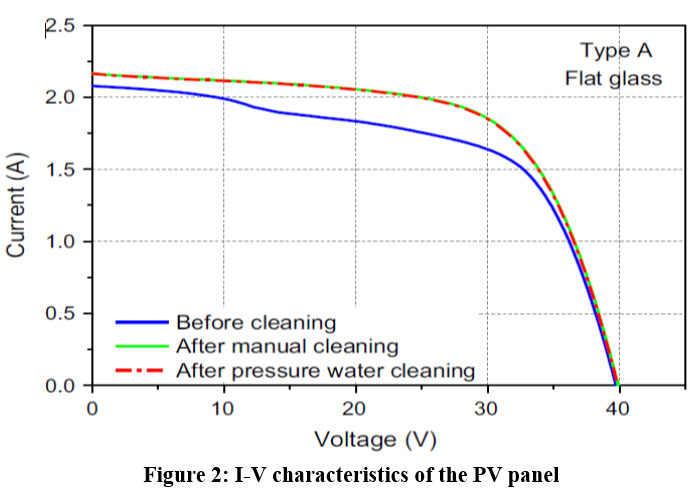 | Figure 2: I-V characteristics of the PV panel
|
According to research conducted by Rashmi Chawla at YMCA University of Science and Technology5, dust gathering on panels significantly impacts their concert parameters. Therefore, adopting appropriate techniques to mitigate losses caused by dust is essential. Regularly cleaning solar panels to remove dust and other debris from their surfaces remains a key solution to minimize energy losses and sustain panel efficiency.
Methodology
Methodological Approach
The foundational pillars of the methodology included Data Accumulation and Analysis, Design, Simulation and Analysis, Optimization, and Experimental Testing. Design considerations were applied after analyzing the data from primary and secondary sources, encompassing both quantitative and qualitative aspects. A CAD model was created, taking into account all the necessary parameters resulting from the data analysis.
Subsequently, Simulation, Analysis, and Optimization were performed for the entire design structure and individually for the major components. A series of experiments was accompanied to appraise the performance of that system.
In future, Simulation, Analysis, and Optimization will be carried out for the overall design structure and major components. A set of experiments will be conducted to assess the functionality of the cleaning system9. Depending on the experimental feedback, if the results are to be positive and as expected, a scale-down model will be manufactured at the same college in the Mechanical engineering department. If the outcomes deviate from expectations, a review of the design, analysis, and optimization is to be conducted to address the noted aspects for redesign10.
Upon successful completion of the scale-down prototype, efforts will be directed towards making it user-friendly through the development of a mobile app and ensuring ease of assembly and disassembly.
Design
Solar Panel
To gain insights into the challenges faced by the company, a comprehensive analysis of the solar panel's location was conducted, emphasizing the significance of its positioning.
The solar panel at PDEA's College of Engineering, Manjari, is manufactured by WAAREE and belongs to the WS-330 module. Its electrical characteristics under Standard Test Conditions (STC) are as follows 11:
Nominal Maximum Power (Pm): 330 W
Circuit Voltage : 46.70 Volt
Short Circuit Current: 9.25 Amp.
Voltage at Max. Power: 37.95 Volt.
Current at Max. Power: 8.70 Amp.
Max. Voltage: 1500 Volt DC
Maximum Series Fuse Rating: 15 Amp.
L x W x T: 1960 x 990 x 40 dimensions in mm.
Weight: 22.50 kg
These specifications are evaluated under STC conditions, which include 1000 W/m2 of irradiance, AM 1.5 spectrum, and the cell temperature is 25°C.
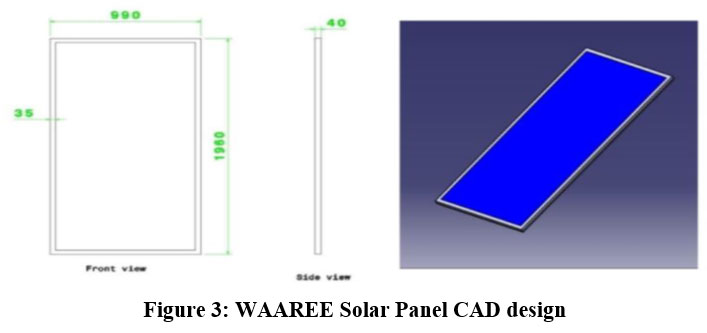 | Figure 3: WAAREE Solar Panel CAD design
|
For the Simulation, the Solar panels situated on the terrace of same college mentioned above were first designed. Exact measurements were taken on-site, and based on those measurements, rough 2D figures were created. Using CATIA V5 software, these 2D figures were subsequently transformed into a 3D design. Given that the Solar panel arrangement comprises 60 panels, only a few were designed on the CAD model for the sake of convenience in simulating the cleaning machine on it. The design is as shown in Figure 4. 
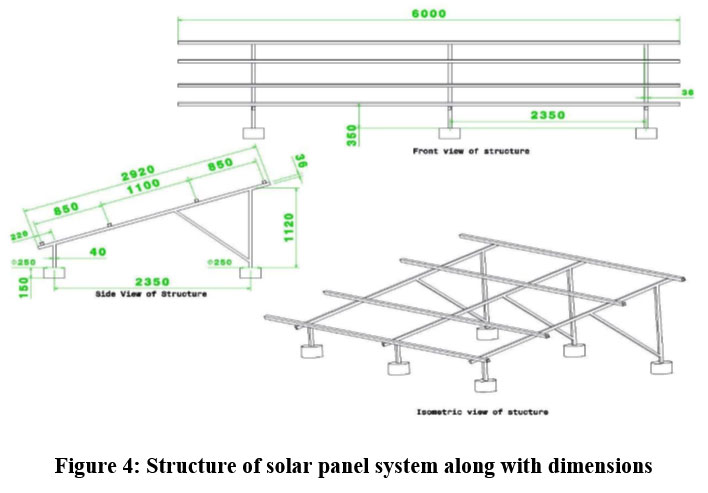 | Figure 4: Structure of solar panel system along with dimensions.
|
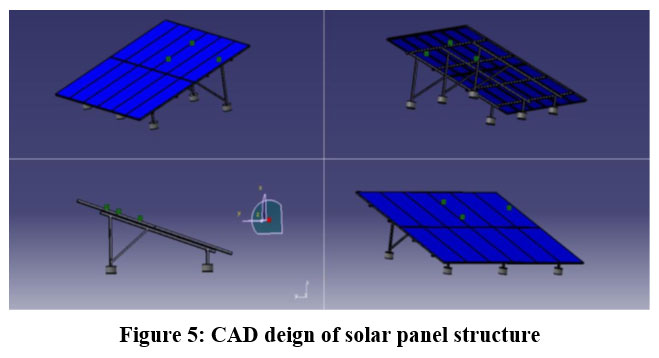 | Figure 5: CAD deign of solar panel structure.
|
Locomotion Unit
The Locomotion Unit plays a vital part in facilitating the machine movement across the panel. Initially, the machine's design features a progressing brush that smoothly traverses along a series of solar panels. To achieve this, the machine securely attaches to the panel arrangement with rollers that hold the panel's edge of frame, effectively utilizing them as rails for seamless movement. The primary cleaning mechanism involves a spinning brush that effectively clears any accumulated dust or debris on the panel surface11.
The system is designed for application on large-scale commercial solar arrays commonly found on school campuses and within industrial settings. Users can easily install the machine onto a panel array and leave it to operate autonomously. The machine is designed to function without the need for human control or regular maintenance, providing a user-friendly and efficient solution for solar panel cleaning11.
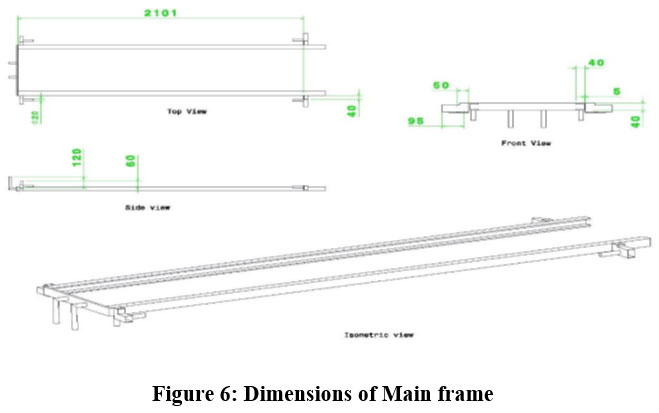 | Figure 6: Dimensions of Main frame.
|
The two L-shaped channels are positioned at the top of the mainframe. These L-shaped channels are installed for safety reasons and to prevent damage to the solar panels. In the event of a wheel failure that may cause the machine to tip over, given the angle of the solar panels, these L-shaped channels will serve to prevent the machine from falling and will secure the machine in a suspended position on the solar panel frame itself.
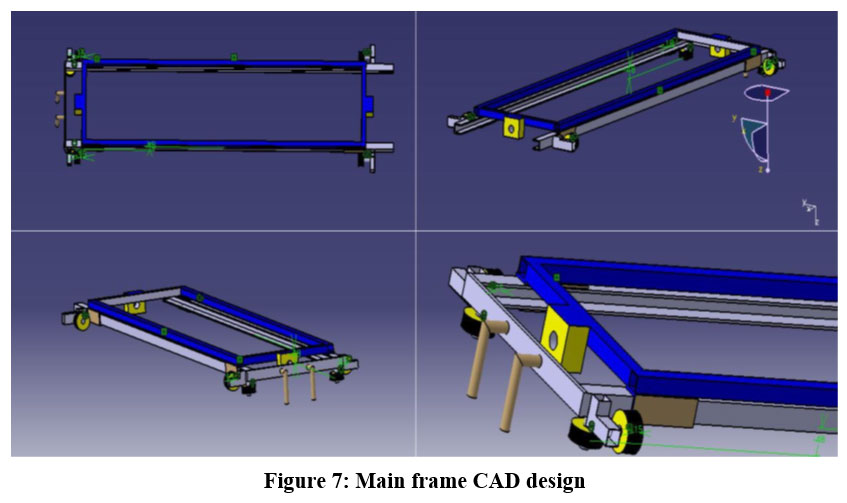 | Figure 7: Main frame CAD design.
|
Plastic wheels are provided to grip on the Solar panel structure frame and get the proper traction for the movement of the machine.
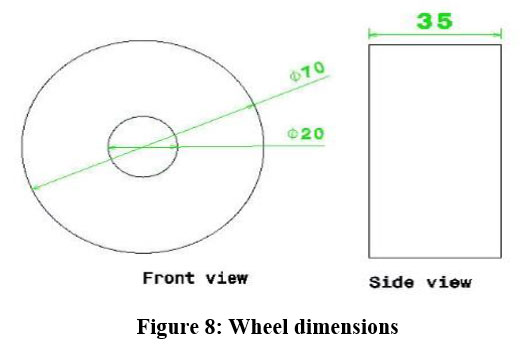 | Figure 8: Wheel dimensions
|
Roller Frame
The Roller Frame is maintained as a separate component from the Mainframe. Given the diverse orientations and sizes of solar panels available in the market, the decision has been made to keep the Roller frame distinct. This Roller frame will accommodate the shaft and motor for the cleaning brushes and can be adjusted in size to align with different solar systems and customer requirements while retaining the same main frame. The Roller frame is designed with C sections, allowing it to be attached to the mainframe using nuts and bolts. Through this configuration, the same Mainframe can be employed for various arrangements of solar panel systems.
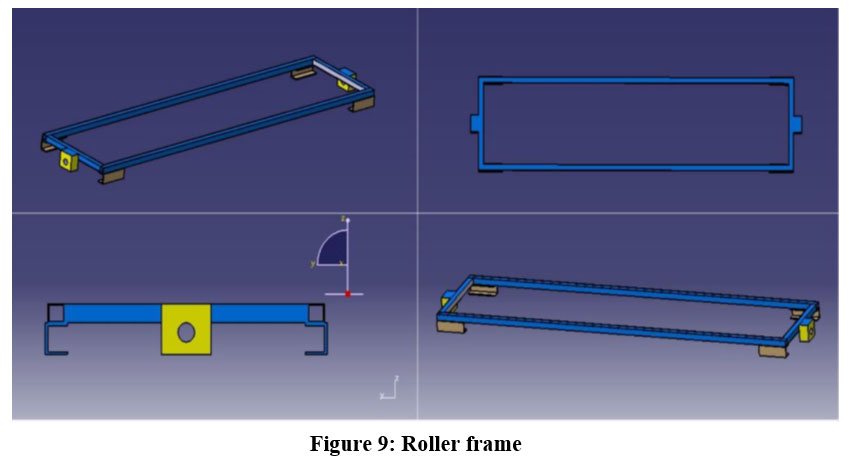 | Figure 9: Roller frame
|
Roller/ Cleaning Brush
In automated solar panel cleaning machines, the material employed for the cleaning brushes plays a crucial role. The machine utilizes rotating brushes made of thread-like bristles crafted from scratch-resistant material to clean photovoltaic and solar panels. This material ensures effective dirt removal without causing damage to the solar panel. Additionally, a water supply system or other detergent solution is positioned in front to proactively address the dirt to be removed11.
In an automated solar panel cleaning machine, soft nylon brushes are utilized to clean the panel. These brushes, which are rotating brushes mounted on the shaft, facilitate the self-cleaning process after dust removal. A sprinkler is also employed for this purpose.
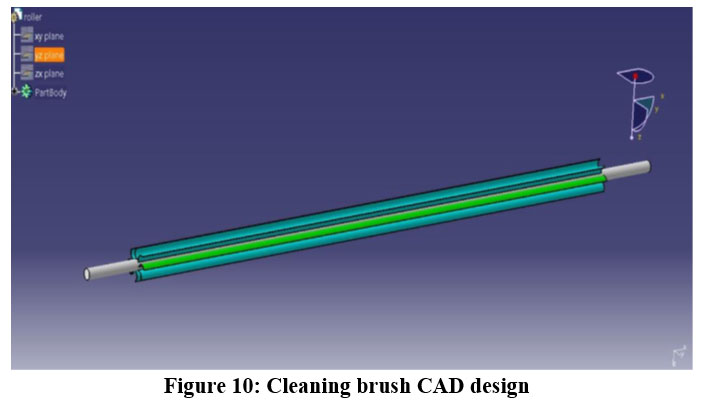 | Figure 10: Cleaning brush CAD design
|
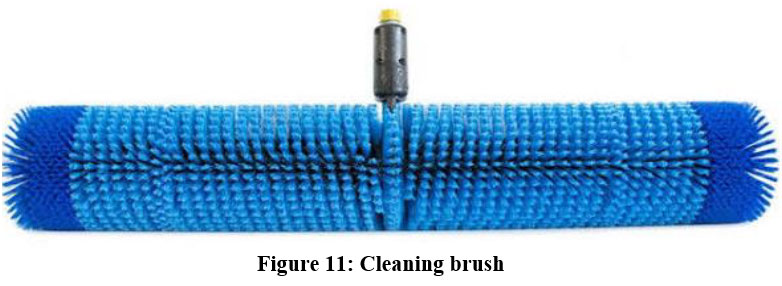 | Figure 11: Cleaning brush.
|
Assembly and Simulation
The cleaning unit is set into operation by moving back and forth along the solar panel. Equipped with a clockwise-rotating cylindrical brush, it travels along the axis of the solar panel, effectively guiding dust along its path of motion and ultimately blustering it away at the edge of panel. Upon reaching the end of the row of solar panels, the direction is reversed, and the cleaning unit returns to its starting point. Once it reaches the initial position, the cleaning unit is brought to a halt. Subsequently, the cleaning unit is activated again, and this process is repeated multiple times to ensure thorough cleaning of the solar panels. Once one array of solar panels is cleaned, the machine can be utilized for cleaning another array.
Simulation is carried out with the assistance of Catia V5. After the assembly of various components of the solar system, such as the Locomotion unit and cleaning roller, various constraints are applied to the parts. A fixed constraint is applied to the Solar Panel System to enable the simulation of the cleaning machine's operation on the panels.
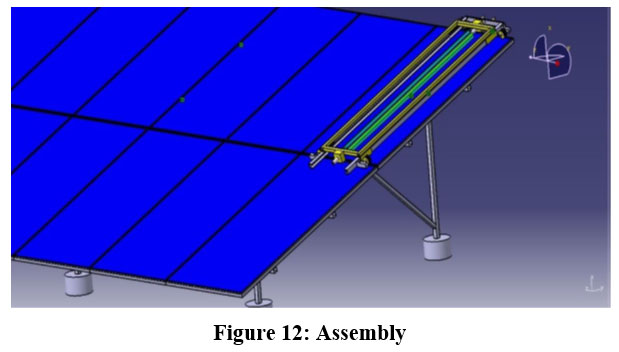 | Figure 12: Assembly.
|
KMU Kinematics interface in Catia V5 is used to simulate the machine. By giving appropriate constraints to parts proper and required Degree of Freedom is established to the Locomotion Unit and Cleaning Roller. Prismatic joints are made Length Driven and values are assigned according to the solar panel system. Revolute Joint is made Angle driven and joint limits are assigned accordingly. Here are some screenshots from the simulation.
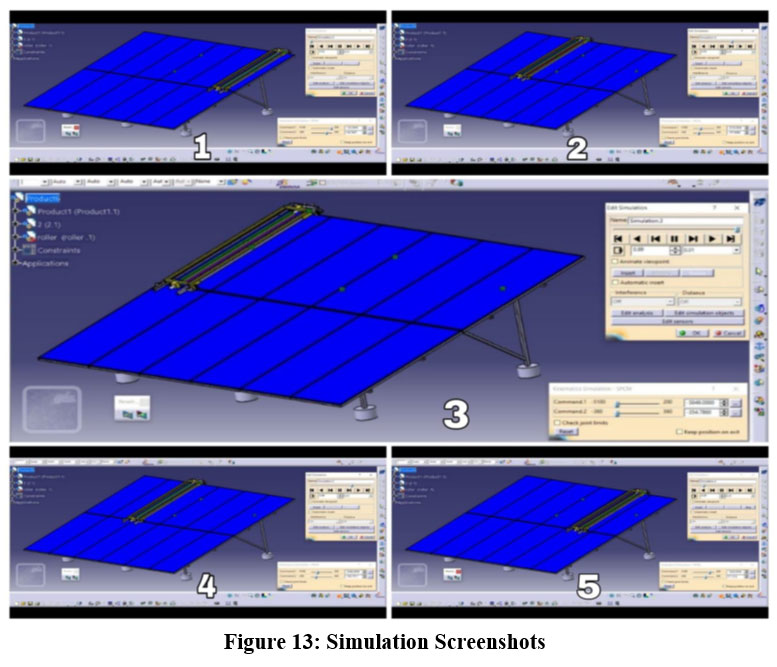 | Figure 13: Simulation Screenshots.
|
The Above figure shows five different screenshots of simulation taken while simulating the machine in KMU Kinematics in Catia V5.
Automation and Working Principle
The Arduino UNO Original R3 is a microcontroller board developed by Arduino officials, featuring the ATmega328P. This Arduino UNO is furnished with 14 digital pins forinput/output, six number of analog inputs, a quartz crystal of 16 MHz, with USB connection, a power jack, an ICSP header, and a reset button11.
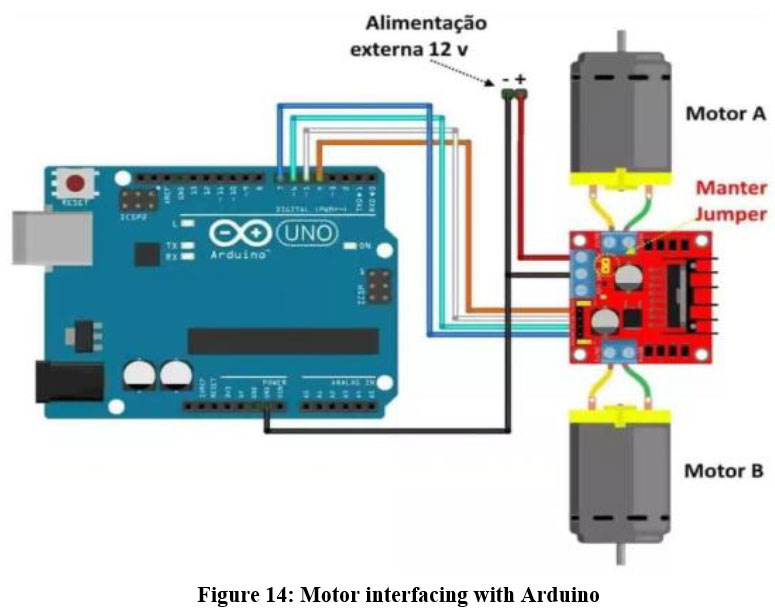 | Figure 14: Motor interfacing with Arduino.
|
Now, the machine is equipped with two IR sensors at both ends, which are connected to the Arduino. Additionally, there are two DC servo motors responsible for propelling the machine, and one DC motor is utilized for rotating the shaft on which the cleaning fiber is mounted. Through programming, instructions are conveyed to the Arduino, which subsequently issues commands to the sensors and motors.
Upon powering on the machine, electricity is directed to the Arduino and other integral components. The initiation of the motors prompts the machine to begin its movement and initiate the brushing operation on the panel. Once the machine reaches at the end of the panel, the IR sensor, strategically mounted on the machine, detects the edge of the panel. This detection is facilitated by a special triggering object positioned at the solar panel's end. Subsequently, the sensor registers the object and transmits a signal to the Arduino, prompting it to halt the motor. This marks the completion of the cleaning cycle for one row of panels.
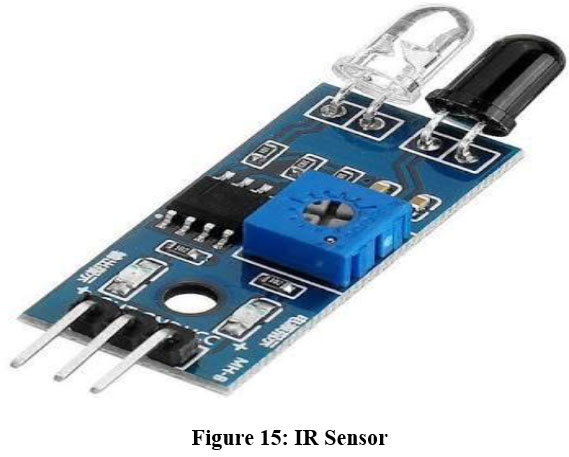 | Figure 15: IR Sensor.
|
Design Calculation
To achieve the enhanced design and the desired output, a thorough analysis of various parameters was deemed necessary. Through the calculation of these parameters, the appropriate dimensions for the product can be determined.
Frame
Material: A6061 (Aluminium)
Density = 2.7 g/cm³
Tensile strength (?t) = 124–290 MPa (18.0–42.1 ksi)
Young's modulus (E) = 68 GPa (9,900 ksi)
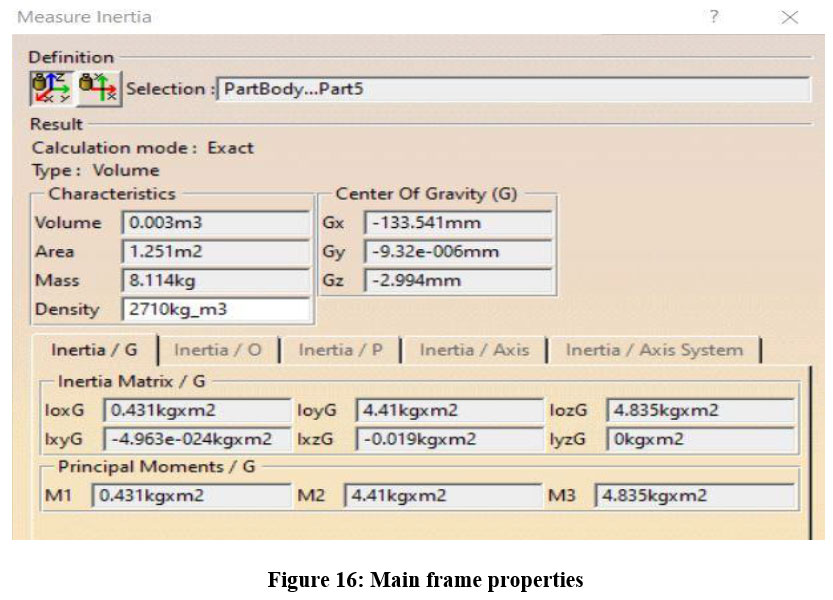 | Figure 16: Main frame properties.
|
Specification of Battery
Voltage = 12V
Current = 5A
Power: 12*5 = 60 W/hr.
Lead acid battery with 50% Efficiency with usable power 42W per hour.
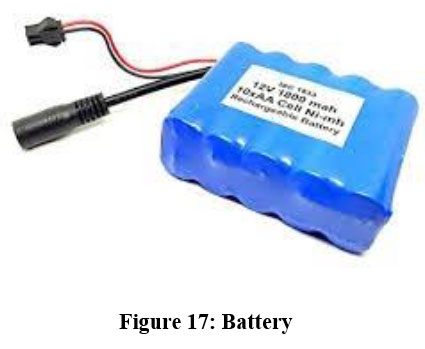 | Figure 17: Battery.
|
Model: Robodo REL- 32 Johnson Geared motor.
Motor Power = 12V
Motor speed = 200 rpm
No-load current = 800 mA
Load current = 9 Amp.
Stall torque = 12 kg-cm
Weight = 300 grams
Voltage = 6 to 24 (nominal voltage - 12v)
Shaft Power transmitted
P = (2?NT) / 60………… (N= rpm of motor)
T = Torque = 12 kg-cm = 12*0.098 = 1.176 N-m
P = (2?*200*1.176)/ 60
P = 36.86 W
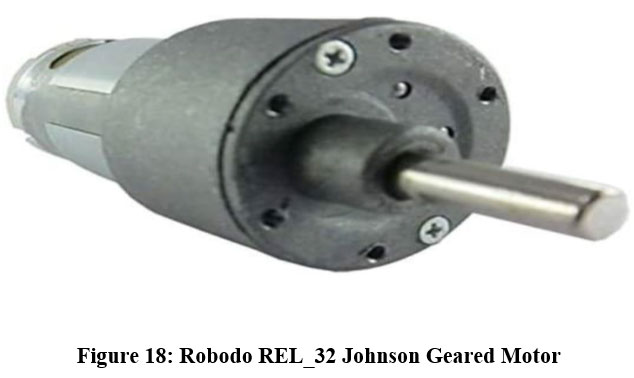 | Figure 18: Robodo REL_32 Johnson Geared Motor
|
Solar Panel Calculations
Consider peak panel power 330W for single panel,
60 panels will produce = 330*60 = 19800
W = 19.8 KW, this is the peak power output by 60 panels.
Consider these panels receive 1 hour of sunlight
So, energy produced = 19.8*1 = 19.8 kWh
This energy produced in kWh is familiar rather similar to the unit used in electric meter.
Discussions
Addressing the issue of dust settling, virtually all overhead residential and commercial solar panels face this challenge. The central objective was to initiate efforts that would decrease maintenance expenses and time for consumers.
The process commenced with the design and analysis of a prototype using CAD software. The resulting machine features a sturdy yet simple frame, ensuring easy transport and use across various panel locations. The cleaning cloth, crafted from microfiber, offers convenience as it can be easily washed, rendering it suitable for domestic consumers. Furthermore, the system's advanced controller permits potential mobile operation, a beneficial feature for large-scale solar parks if demand arises. Equipped with sensors, the system enables seamless cleaning without human intervention and can halt or pause cleaning in the event of encountering an obstacle.
The machine's design was informed by insights from numerous industry experts specializing in cleaning technologies. While developing a fully functional machine wasn't feasible within the scope of this endeavour due to factors like time constraints and manufacturing costs, a scaled-down prototype was meticulously designed, analyzed, and subjected to testing.
Conclusion
The systematic automated solar panel cleaning mechanism has been developed to counteract the detrimental effects of soiling on photovoltaic cells. Several issues encountered in manual panel cleaning, including damage caused by brushes, increased risk to personnel, and ineffective cleaning, are addressed by this innovation. While there are some atomized water cleaning machines in the industry, they tend to consume excessive amounts of water, making them unsuitable for arid regions. Both residential and commercial consumers are served by the mechanism, which offers automated cleaning capabilities, including obstacle detection through various sensors. The cleaning system utilizes high-quality microfiber cloth to effectively remove dust from panel surfaces without the need for water, making it suitable for arid areas. Additionally, provisions have been included for a water sprinkler to address stubborn stains like bird droppings that cannot be removed solely with the cloth. The overall impact of this mechanism will result in an increased rated power output from the panels, which had previously been compromised due to the mentioned issues. This not only reduces maintenance and repair costs but also extends the lifespan of the solar panels, encouraging consumers to choose solar energy as a viable renewable source. The system frame is robust, easy to manufacture, and poses no threat to the functioning photovoltaic cells, making it the preferred choice for consumers. Once the machine design is finalized, an analysis will be conducted, followed by manufacturing. The analysis phase will encompass static stress analysis of the machine frame and the shaft housing the microfiber cloth. After the frame material is selected, the cleaning cloth will be designed to fit the panel's length and be attached to the machine's shaft. Manufacturing will involve sourcing high-quality local materials and employing precise machining processes to ensure a precise fit and finish for the end product. The machine will then be equipped with sensors for seamless motion control and paired with multiple motors: one for the shaft's movement housing the microfiber cloth and a couple of others for moving the entire frame over the solar panel.
Future Scope
Numerous aspects and concepts can be adapted in response to changing consumer needs in the future. The problems faced today may become less relevant due to technological advancements. Therefore, to accommodate these evolving needs, the flexibility to make design changes as required must be ensured. The objective is to set a new standard in solar panel cleaning by harnessing cutting-edge technology to replace traditional methods. With this approach, valuable resources like water, time, and money are aimed to be conserved. In comparison to other methods, which typically incur annual maintenance costs equivalent to approximately 5% of the total plant cost, a reduction in these expenses by 2% has been demonstrated by the robot-based cleaning system. Solar farms can be efficiently cleaned on demand by the autonomous robot, eliminating the need for manual labour and minimizing water consumption. The system has been upgraded with additional features aimed at augmenting its capabilities. These enhancements include the incorporation of de-ionized water cleaning, a built-in camera for inspection purposes, and climate-based cleaning capabilities. These enhancements not only optimize cleaning performance but also enable remote farm inspection, eliminating the need for physical site visits. Furthermore, a forward-thinking approach allows for potential weight reduction and the development of a more compact system through the utilization of emerging technologies. As the demand for solar systems increases in both industrial and residential settings, the cleaning system holds significant promise for a bright future. Regarding the machine's current design, it is affixed to a long frame, making transportation challenging. To address this issue, consideration can be given to implementing a foldable frame or one that can be disassembled with nuts and screws, facilitating easy relocation. Additionally, an upgrade of the current single-axis motion mechanism to a double-axis mechanism for improved functionality can be explored. Furthermore, by leveraging the Internet of Things (IoT), remote operation of the system in distant locations can be enabled. This same technology can also serve as an observation tool, providing real-time information on the number of panels cleaned and the operational status of all the mechanism's components.
Acknowledgements
We would like to express our sincere gratitude and appreciation to PDEA’S College of Engineering, Manjari, Pune (MS) India for providing us with the invaluable opportunity to engage in research work during our time here. This experience has been transformative and has enriched our academic journey in countless ways. The opportunity to undertake research at this has not only enhanced our academic growth but has also equipped us with valuable skills, critical thinking abilities, and a profound passion for inquiry. Furthermore, I would like to extend our gratitude to our students who have shared their insights and ideas, creating a collaborative and stimulating atmosphere that has propelled our research forward.
Conflicts of interest
There are no conflicts of interest among any of the authors.
Funding Sources
This research work has not received any financial support from any funding organization or agency, neither partially nor in its entirety. The authors have not received any sustenance from any organization for this work presented in this manuscript.
References
- Burton Patrick D., Bruce H. King, Riley Daniel, Predicting the spectral effects of soils on high concentrating photovoltaic systems, Solar Energy, 2015, vol. 112, pp. 469-474,.
CrossRef - Hussain Athar, Batra Ankit, Pachauri Rupendra, An experimental study on effect of dust on power loss in solar photovoltaic module. Renewables, 2017, 4, Article No.9.
CrossRef - Kazem Hussein A, Chairchan Miqdqm, Ali H Al-Waeli, Ali, Kamaruzzaman Bin Sopian, A review of dust accumulation and cleaning methods for solar photovoltaic systems. Journal of Cleaner Production, 2020. 10.1016/j.jclepro.2020.123187.
CrossRef - Arash Sayyah, Mark N. Horenstein, M. K. Mazumder, Mitigation of soiling losses in concentrating solar collectors. Conference Record of the IEEE Photovoltaic Specialists Conference 2013, 0480-0485. 10.1109/PVSC.2013.6744194.
CrossRef - Chawla Rashmi, Singhal Poonam, Garg Amit Kumar, Impact of Dust for Solar PV in Indian Scenario. 2019, 10.4018/978-1-5225-8085-0.ch005.
CrossRef - Alaoui Soukaina M. Ayane , Dounia Dahlioui, Barhdadi Abdelfettah , PV Modules Self-Cleaning Solutions and Transmittance Loss Measurements, 6th International Renewable and Sustainable Energy Conference (IRSEC)2018, 1-4. 10.1109/IRSEC.2018.8703022.
CrossRef - Deb Dipankar, Brahmbhatt Nisarg L. Review of Yield Increase of Solar Panels Through Soiling Prevention, and a Proposed Water-free Automated Cleaning Solution. Renewable and Sustainable Energy Reviews. 2017. 82.10.1016/j.rser.2017.10.014.
CrossRef - Zeki Ahmed Darwish, Kamaruzzaman Sopian, Ahmad Fudholi, Reduced output of photovoltaic modules due to different types of dust particles. Journal of Cleaner Production. Vol.280, Part1. https://doi.org/10.1016/j.jclepro.2020.124317.
CrossRef - Tamadher M.A Alnasser, Aedah M.J Mahdy, Khallel I. Abass, Chaichan Miqdam, Hussein A Kazem. Impact of dust ingredient on photovoltaic performance: An experimental study. Solar Energy 2020, 195. 651-659. 10.1016/j.solener.2019.12.008.
CrossRef - Alghamdi Abdulsalam, Abu Bakr S. Bahaj, Luke Blunden, Yue Wu, Dust Removal from Solar PV Modules by Automated Cleaning Systems. Energies 2019, 12(15), 2923; https://doi.org/10.3390/en12152923.
CrossRef - Brian Parrott, Pablo Za C.nini, Ali Shehri, Konstantinos Kotsovos, Issam Gereige,. (2018). Automated, Robotic Dry-Cleaning of Solar Panels in Thuwal, Saudi Arabia using a Silicone Rubber Brush, Solar Energy 2018, Volume 171, Pages 526-533.
CrossRef







